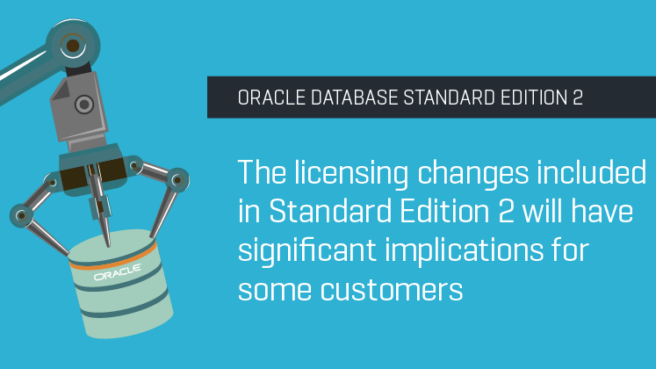Oracle Database Standard Edition 2 Raises Licensing Questions

In August 2015 we published a blog commenting on the impact of the newly available Oracle Database 12c Standard Edition 2 (SE2) for existing Oracle Standard Edition (SE) and Standard Edition 1 (SE1) customers.
The blog remains popular with our readers so we have updated it to include the facts we now know. SE2 is essentially a replacement of SE and SE1. Customers can no longer purchase these two legacy versions. However, the licensing changes included in SE2 will have significant implications for some customers.
The headlines
- Real Application Clustering is included with SE2 at no additional cost
- SE2 may be deployed on servers with a maximum of two physical sockets (even if unoccupied), either on a standalone server or in a RAC Cluster (SE allowed four physical sockets per server)
- If using Named User Plus (NUP) licensing, there is now a minimum requirement to license 10 NUPs per server (rather than five NUPs per organization as previously with SE and SE1)
- SE2 is limited to utilizing 16 CPU threads at any time (previously there was no limit)
- SE2 is priced exactly the same as SE.
There are cost implications for customers looking to upgrade from SE or SE1, some of which are extremely significant. Below we cover six different configurations that you may have and the actions you need to take.
Scenarios requiring no additional cost
- You currently have Standard Edition deployed on a server with a maximum capacity of two sockets and you want to make use of the latest version. Assuming that you have an active support maintenance contract, you can install Standard Edition 2 at no additional cost.
- You currently have Standard Edition deployed on a two-server cluster (using Real Application Clusters), where each server has one physical socket. This setup is valid for SE 2. If you want to upgrade to SE 2 you can install it at no additional cost, assuming you have an active support maintenance contract.
Scenarios requiring additional cost
- You currently have SE1 installed and want to upgrade to SE2. In this case, you must upgrade your existing Oracle Standard Edition One licenses to Standard Edition Two, which requires additional license and support upgrade fees.[1]
- You currently have SE on a four-server cluster (using Real Application Clusters), each with one physical socket. If you want to make use of the latest version, you have to remove two servers from your cluster before deploying SE2 because SE2 may only be licensed on a maximum of two single-socket servers in a RAC setup.
Scenarios requiring hardware changes
- You currently have SE deployed on a two-server cluster (using Real Application Clusters), where both servers have a maximum capacity of two physical sockets. If you want to make use of SE 2 or upgrade to the Enterprise Edition (EE), you must change your hardware to a cluster with two servers, each having a maximum capacity of one physical socket – a costly option.
- You currently have Oracle Database SE on a server with a maximum capacity of four physical sockets. In order to upgrade to SE2, you would have to change hardware and replace your server with one that has maximum capacity of two physical sockets.
Implications of the change – a worked example
For customers that have deployed SE on a VMware cluster containing only hosts with a maximum of four sockets, there are serious ramifications. SE has a minimum of five Named User Plus (NUP) licenses per organization (not 25 per processor as with EE) – and NUP is a server-independent metric. Organizations can use the NUP metric as a method to limit the number of licenses required for the total number of NUPs in soft-partitioned virtualized environments.
Let’s consider a situation where a company has deployed SE on a VMware cluster with 2 ESX-hosts with each host containing four sockets. Each socket is occupied with a dual core Intel CPU. The company has 20 individuals authorized to use the database. This means you would only need 20 NUP licenses for SE (which would cost $7,000 at the current list price of $350 per NUP). But if you upgrade to SE2, that cluster would no longer meet the restrictions, because it has more than two physical sockets per host.
You would need to move to a new cluster with hosts that contain two physical sockets per host, or license EE. If you license EE on NUP, the original cluster would require a minimum of two (hosts) x four CPUs x two cores per CPU x 0.5 core factor x 25 NUP minimum = 200 NUP. This has a list price of $950 per NUP, so this would mean a bill for $190,000. Neither of these options looks very attractive.
Summary
Whatever situation you find yourself in, it’s crucial to have a clear view of your estate to make the correct decisions when performing an upgrade or hardware change. If you’d like to get a clear idea of the licensing situation within your environment, consider using Snow’s Oracle Management Option to gain visibility of your entire IT estate.
[1] A 20% uplift in support fee on average, according to the Oracle Database Standard Edition 2 brief